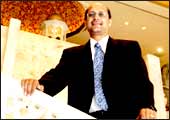|
Just
about when everybody thought that the war for durability in the
Rs 25,000-crore consumer electronics industry in India had been
fought and won, the industry seems to be gearing up for another
battle. On the face of it, nothing seems to have changed, not
the game, nor the players and not even the prize. The industry
continues to grow sluggishly, an 8 per cent compounded average
growth rate (CAGR) between 2000 and 2004 (China grew 14 per cent
CAGR during this period), LG and Samsung continue to rule the
market, accounting for around 50 per cent of the total Rs 25,000-crore
industry and the other Indian as well as multinational players
like Videocon, BPL, Mirc Electronics, Whirlpool, and Sony continue
to play catch-up. Under the surface though, things are stirring.
For one, the also-rans are refusing to play
their part and are making a strong comeback bid. "It is not
for nothing that the Devil (a character that represents brand
Onida) is back," gushes Gulu Mirchandani, Chairman and Managing
Director (MD), Mirc Electronics. "He is here to rule the
market again." Apart from televisions, where it has historically
held its own against competition, Mirc is making an aggressive
play in categories such as washing machines, air conditioners,
microwave ovens and DVDs. Then, says Mirchandani, there are exports.
He claims to have sold between 100,000 and 150,000 colour televisions
(CTVs) each in Ukraine and Russia last year, and hopes to translate
this into a competitive advantage in the Indian market.
 |
Venugopal Dhoot
Chairman/Videocon
"If there is one player that will thrive in the
Indian market, other than the Koreans, it is Videocon" |
BPL Ltd, which ruled the CTV market in India
till early 2000 and then slipped into heavy losses (the net loss
stood at Rs 214 crore in 2003 and Rs 74 crore in 2005), has formed
a 50:50 joint venture (JV) with Japan's Sanyo Electric. The latter
has committed $100 million (Rs 450 crore) to its Indian operations.
The JV has launched CTVs, LCDs and plasma screens under the Sanyo
and BPO brand names and is also foraying into refrigerators, washing
machines and DVDs. "We intend to be a Rs 2,000-crore venture
by 2009 with a considerable market share in all segments,"
says Ajit Nambiar, Chairman and Chief Executive Officer, Sanyo
BPL.
Videocon Industries, another leading Indian
player that got battered during the late 90s and early 2000s,
boasts revenues of Rs 4,500 crore today. The group's oil business
contributes significantly to this, but the consumer electronics
business is thriving, too. Chairman Venugopal Dhoot identified
a different route to growth: acquisition, of flagging brands such
as Sansui, Akai, Allwyn, Kelvinator, Hyundai, Toshiba and Electrolux
in the domestic market, and of manufacturing facilities such as
French electronics major Thomson's colour picture tube one, globally.
"If there is one player that will thrive in Indian market,
besides the Korean majors, it is Videocon," says Dhoot.
Whirlpool India is another company, which
after a long cold winter, is getting back into shape. The company,
which recorded a net loss of Rs 38 crore in 2005-06, recently
announced a $20-million (Rs 90 crore) investment for 2006 and
2007 and launched several new products. The company, says Arvind
Uppal, its Managing Director, is committed to India. Then, there
are others like Godrej Appliances, Sony, Haier, Sharp, Hitachi
and various other smaller companies that are aiming to corner
some share in the industry.
 |
Gulu Mirchandani
Chairman & MD/Mirc Electronics
"It is not for nothing that the Devil (a character
that represents Onida) is back. He is here to rule the market
again" |
All This And No Growth
These ambitious plans and strategies would
not seem misplaced if the consumer electronics industry were growing
the way other industries are. Last year, when GDP grew by around
8.1 per cent, the stock markets boomed and most industries, even
those that had been in dire straits, like fast moving consumer
goods, grew at between 15 and 30 per cent, consumer electronics
was one sector that grew only 5 per cent. In terms of value, the
biggest constituent of the segment, CTVs, actually saw a decline
(see State Of The Market). Nor are growth estimates for the future
any more sanguine. According to market research agency Datamonitor,
the industry is likely to grow around 7.7 per cent CAGR for five
years ending 2009.
There are many reasons for sluggishness in
the industry; some immediate and others, historical. Most people
attribute last year's slow growth to two factors-confusion regarding
value-added tax (vat) and a surge in stock markets. "Confusion
regarding vat in the first quarter last year took a heavy toll
on sales," says K.R. Kim, President, LG Electronics. Then,
experts point out an intriguing correlation between stock markets
and consumer durables industry. "It has been observed that
whenever stock markets or real estate sectors are booming, consumers
tend to postpone their consumer durable purchases and invest their
money in these assets," says Bhuwan B. Singh, Director (Client
Service), org-GFK.
Then, there are historical reasons. When
the government opened up the sector, recalls Mirchandani, incumbent
players "were not ready for competition and most of them
died or are still bleeding". Videocon's Dhoot holds heavy
taxation responsible for industry's woes. "Total tax incidence
in India even now stands at around 25-30 per cent, whereas the
corresponding tariffs in other Asian countries are between 7 and
17 per cent," he says.
CONSUMER DURABLE STOCKS
Children Of A Lesser Boom |
| Consumer durables
is one sector that hasn't benefited from the bull run on the
bourses. All consumer durables stocks, save Videocon, remain
totally untouched by the boom, and trade between Rs 26 and
Rs 40. "Margins in this business have been under tremendous
pressure and bottomlines have not been growing," says
Ambareesh Baliga, Vice President, Karvy Stock Broking. Videocon
Industries is the only company quoting a respectable Rs 449,
but an analyst points out that the stock regained its buoyancy
only after Videocon International's merger into the company.
Gulu Mirchandani, Chairman and Managing Director, Mirc Electronics,
proffers another reason for investor apathy. "If the
market leaders (read LG and Samsung) had been listed, the
sector could have attracted investors." |
| THE OTHER ONES |
 |
| Salora's Jiwarajka: Knows the
hinterland |
The India that lives in its
villages still remains relevant for some consumer durables
companies. This India, at least a large proportion of its
constituents, still buys black and white TVs and doesn't
know what flat screens are. As for brands, it's a different
world altogether. Brands such as Texla, Salora, T-Series,
Weston and Oscar compete with LG and Samsung in these markets
(and in several, it is the better-known firms that are absent).
The 'bit players' together account for about 8-9 per cent
of the TV market (both CTVs and B&W TVs; some two million
B&W TVs were sold in 2005-06). "We don't compete
with the LGs and Samsungs. We cater to the non-metro market
that we know very well and are in a position to serve very
well. We'll continue to be in business because there is
demand for our products and we enjoy our customers' trust,"
says Gopal Jiwarajka, Managing Director, Salora International
Ltd, a mid-sized conglomerate, which sells about 100,000
CTVs a year (net sales of Rs 584.26 crore and net profit
of Rs 10.7 crore in 2005-06). The company has recently more
than doubled its manufacturing capacity and tied up with
Japan's TEAC Corporation to launch TEAC-branded audio-visual
products in India, including LCD and plasma TVs.
-Kapil Bajaj
|
Poor infrastructure is another reason that
seems to have held back the industry. "Regular power supply
is imperative for any consumer electronics product. But that remains
a major hiccup in India," says Ravinder Zutshi, Deputy Managing
Director, Samsung.
 |
Ajit Nambiar
Chairman & CEO/ Sanyo BPL
"We intend to be a Rs 2,000-crore company by 2009 with
a considerable market share in all segments" |
Indeed, over 80 per cent of the rural market
in India remains irrelevant for the industry because of these
reasons. But the fact remains that these problems are not going
to be resolved in the near future. And companies will have to
factor them in when they draw new growth plans. Which they have
now done. Shorter replacement cycles, especially in urban areas,
also give companies cause for hope. Over the next few years, the
topography of the industry will likely change, with some companies
gaining at the expense of others. Eventually, however, the market
itself will grow, as rural markets evolve and companies create
specific products for them.
The Threat Of Retail
There is another imminent threat for the
industry, the emergence of organised retail. "World over
consumer electronics is used as a loss-leader category to woo
consumers," says Ireena Vittal, Principal, McKinsey. "Retailers
give consumers huge discounts on these products to win over consumers,
which, in turn, means squeeze on margins." Vittal points
to another trend that is sure to hit the players, that of organised
retailers launching their own store brands. That, in fact, is
already happening. Electronic Bazaar, the consumer electronics
division of the retail chain Big Bazaar, has started importing
air conditioners and microwave ovens from China and is selling
them, under the brand name Koryo, at prices that are over 40 per
cent cheaper than those of competing products. "Initial response
to these products has been quite encouraging," says MD Kishore
Biyani. "We intend to import other products like TV and washing
machines soon."
 |
 |
Kishore Biyani
Managing Director/ Future Group
"Initial response to ACs and microwave ovens imported
from China has been quite encouraging. We intend to import
other products soon" |
R. Zutshi
Deputy Managing Director/ Samsung
"The Indian market
remains heavily under-penetrated, which is
a big opportunity for
all players" |
Mukesh Ambani's Reliance Retail is also said
to be exploring such opportunities. In fact, the group is said
to be in talks with some companies that neither have any manufacturing
facility nor a strong distribution network in the country, but
are keen on a presence here. "There are companies that can
take advantage of the free trade agreement (FTA) route and import
their products to India and then, sell them through us without
making any ground-level investments," says a senior executive
at Reliance Retail. To be sure, companies like Hitachi, Sharp
and TCL Holdings are already looking at exploiting the FTA route.
"We are looking at increasing our market share in CTV, LCD
and plasma screen business," says Prasun Banerjee, Vice President
(Sales and Marketing), Sharp India. "We would largely be
importing these products, making use of the FTA route."
| THE INDIAN REVIVAL |
| BPL Ltd: Has formed a 50:50 joint venture
with Japan's Sanyo Electric, which is investing $100 million
(Rs 450 crore) in Indian operations; looking at global markets;
claims to be exporting to 30 countries already; has targeted
Rs 2,000 crore in revenues by 2009.
Videocon Industries: Chairman Venugopal Dhoot has
been on an acquisition binge (brands such as Kelvinator
and Electrolux in India; French electronic major Thomson's
colour picture tube business) and intends to beat the Koreans
in their volumes game.
Mirc Electronics: Gulu Mirchandani, the Chairman
and Managing Director, feels that a larger product portfolio,
extended presence in high growth segments like DVD players,
microwave ovens, air-conditioners and exploring under-penetrated
global markets, like Russia and Ukraine, will help.
Godrej Appliances: Thus far, had only refrigerators,
washing machines and air conditioners in its portfolio;
now planning to enter categories such as microwave ovens
and DVD players, maybe even televisions; exports is an immediate
target.
|
AFTER-SALES SERVICE
Not Quite Sell And Forget |
 |
| Salora's Jiwarajka: Knows the
hinterland |
Lifecycles may be falling,
and consumers may be replacing products far more frequently,
but that hasn't changed the contours of after-sales service
in the consumer durables industry. Anecdotal evidence on
the indifference of companies to faulty products and aggrieved
consumers abound with the popular opinion being that companies
consider their time better spent selling products rather
than servicing them. Girish V. Rao, Vice President (Sales
and Marketing), LG Electronics India, believes that this
isn't quite true. "It is a misconception that after-sales
service is becoming irrelevant or that the industry can
afford to ignore it." "At LG," he adds, "we
see it as one of the differentiators of our business from
the competition's." Rao is right: with replacement
cycles becoming shorter, companies should do everything
in their powers to keep consumers happy (a happy consumer
could well pick the same brand when it is time to do so).
Only, not too many consumer durable manufacturers seem to
have realised that. Result: some outsource their service
function and others appoint franchisees to handle it.
-Kapil Bajaj
|
It is not that the players are oblivious to
these challenges; they have no option but to look at the brighter
side of the picture, which in India's case is its potential. "The
Indian market remains heavily under-penetrated, which is a big
opportunity for all players," says Zutshi.
 |
K.R. Kim
President/LG Electronics
"In the next two to three years, half the players will
be pushed to fringes again. Only two to three players will
survive in each category" |
Then, foraying into rural markets has a considerable
cost component attached to it. Companies not only have to set
up the basic infrastructure in terms of office space, manpower,
but also spend on transportation for moving inventory. Even LG
and Samsung, which are touted as having the largest distribution
network in the country, have a direct presence only in 15,000
to 18,000 of the around 40,000 retail outlets (for consumer durables)
in the country.
Players admit that the increasing competition
and new challenges will lead to another phase of consolidation
with some losing and others winning. Early indications of that
are already visible. The buzz in the market is that Samsung incurred
losses (around Rs 80-100 crore) for the first time in 2005. Zutshi,
however, refutes this. "Our profits did take a hit last year,
but there were no losses." Whirlpool India, Godrej Appliances
and BPL Ltd, companies making a comeback, aren't out of the woods
yet. LG's Kim says that in the next two to three years "half
the players will be pushed to fringes again". "Only
two or there players will survive in each category."
And who are the players who will survive?
Only those who are resilient, committed to the industry and Indian
market and at the same time, are looking at being globally relevant,
is the chorus.
-additional reporting by
Kapil Bajaj
|











